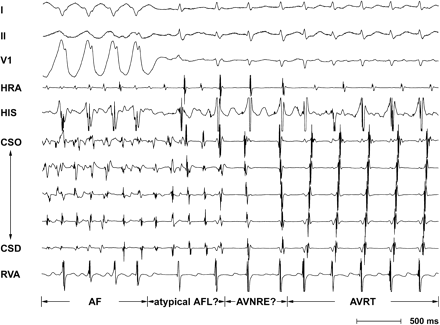-
PDF
- Split View
-
Views
-
Cite
Cite
Jen-Yuan Kuo, Ching-Tai Tai, Shih-Ann Chen, Spontaneous transition of four different types of supraventricular tachycardias in one patient, EP Europace, Volume 6, Issue 3, 2004, Pages 220–221, https://doi.org/10.1016/j.eupc.2003.12.005
Close - Share Icon Share
A 47-year-old male patient was referred to this laboratory for treatment of frequent episodes of supraventricular tachycardia. He had hypotension with dizziness during tachycardia. The 12-lead ECG during sinus rhythm showed ventricular preexcitation.
During electrophysiological study, right atrial burst pacing induced atrial fibrillation with rapid ventricular rate through the accessory pathway. It was organized to atypical atrial flutter-like tachycardia with 2 to 1 atrioventricular conduction for several beats. (It showed positive F waves in leads II and V1, with irregular cycle length, and was likely either left-sided atrial flutter or a pulmonary vein tachycardia.) Then, two slow–fast atrioventricular nodal reentrant echo-like (AVNRE) beats with possibly retrograde concealed conduction in the left lateral accessory pathway were demonstrated. Finally, antegrade conduction was through the third intermediately conducting AV nodal pathway, the retrograde fast pathway was blocked, and a sustained orthodromic atrioventricular reciprocating tachycardia (AVRT) using the left lateral accessory pathway for retrograde conduction followed (Fig. 1). Alternatively, this intermediate rhythm (AVNR echo beats) was due to low atrial tachycardia beats with a delay in the AV node or via the slow pathway (long AH interval) and the first beat of AVRT was due to an atrial beat with a shorter AH interval or conducting through the fast pathway. The AVRT was confirmed by classical resetting criteria and ventricular pacing manoeuvre during tachycardia. Radiofrequency energy targeted at the left lateral aspect of mitral annulus successfully eliminated the accessory pathway. After successful ablation, antegrade dual AV nodal physiology with retrograde AV nodal conduction was demonstrated. This patient did not have recurrence of supraventricular tachycardia during one and a half-years of follow-up.

Tracing showed atrial fibrillation (AF) with accessory pathway conduction evolving into orthodromic atrioventricular reciprocating tachycardia (AVRT) via two intermediate rhythms: atypical atrial flutter-like (AFL?) tachycardia and slow–fast atrioventricular nodal reentrant echo-like (AVNRE?) beats. CSD, distal coronary sinus; CSO, ostium of coronary sinus; HIS, His bundle recording; HRA, high right atrium; RVA, right ventricular apex.
Coexistence of double supraventricular tachycardias in one patient has been reported [1,,2], and novel mechanisms have been demonstrated in this laboratory [3]. However, coexistence of four different types of supraventricular arrhythmias with spontaneous transition in one patient is rare, and this phenomenon has not been reported in the literature.



